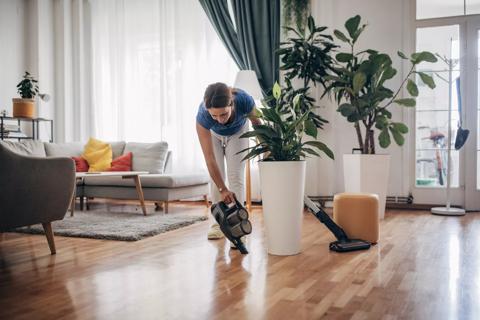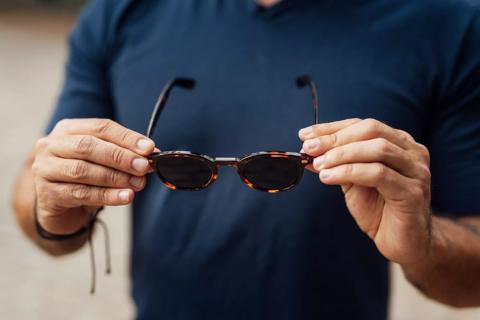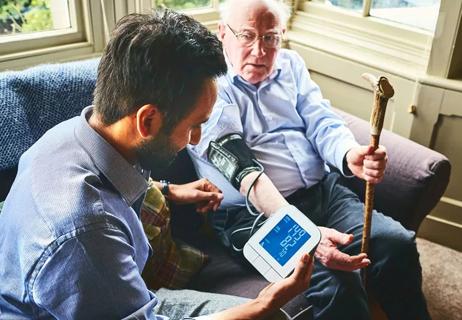A loss of central vision might complicate things behind the wheel

From watching TV and reading a book, to grocery shopping and picking your grandkids up for the weekend — your vision plays a central part in so many activities. But when you get a diagnosis for a condition like wet age-related macular degeneration (wet AMD), you might wonder how certain tasks and hobbies in your life may inevitably change when your central vision is severely affected.
Advertisement
Cleveland Clinic is a non-profit academic medical center. Advertising on our site helps support our mission. We do not endorse non-Cleveland Clinic products or services. Policy
Driving from one location to the next is one activity that might be a top priority of concern if you’ve been diagnosed with wet AMD. What sort of challenges might you face while you’re behind the wheel? What can you do to manage your symptoms without relinquishing your ability to drive yourself? And is there ever a time when driving becomes unsafe for you or others on the road?
Ophthalmologist Danny Mammo, MD, answers these questions, along with reasons why treating wet AMD can be important for driving safely.
Unlike dry AMD, which takes longer to develop, wet AMD can cause changes in your central vision within weeks of developing and can immediately impact certain activities like driving. Wet AMD occurs as a result of abnormal blood vessels in your retina. When these blood vessels burst or leak fluid, it can cause a disruption or obstruction to your central vision.
Your macula, the central part of your retina, is responsible for processing what you see. It helps you clarify the smallest details and focus on specific aspects of what you’re looking at. Wet AMD typically blocks or alters these details and rarely affects your peripheral vision. Some examples of what you could experience include:
Advertisement
Because of these changes, your ability to drive and make out specific details can be affected.
“Driving is difficult if you reach a certain degree of vision loss because you use your central vision to drive, to look at streetlights, see signs and view your dashboard,” says Dr. Mammo.
Some of the driving difficulties you might experience with wet AMD include:
“Nighttime vision can become especially difficult because AMD tends to drastically reduce your contrast sensitivity, so you become more reliant on lights, brightness and contrast,” explains Dr. Mammo.
When you experience these complications, it’s common to seek necessary treatment and make lifestyle changes that can improve your ability to do these activities safely and effectively.
“Without treatment, AMD will progress fairly quickly, and it can be irreversible if you go without treatment for a long time,” warns Dr. Mammo. “But with early treatment, we can reduce the rate of progression and sometimes even improve their vision by starting treatment.”
Retina specialists help administer treatment options like injection medications to help remove excess fluid from your eyes and stop further blood vessels from growing.
Low vision specialists can offer patients assistive tools to help maximize the remaining vision people have. Some low vision specialists can offer vision assistive devices like bioptic driving glasses that can help improve your ability to drive and see things more clearly.
“You work with a low vision therapist to train yourself to be able to use these special telescopic lenses that allow you to drive,” explains Dr. Mammo. “The telescopic glasses are put onto your regular glasses and they will train you to tilt your head or move your eyes up to look through the telescopic part of the lens to see things like street signs, streetlights and other things in your field of vision.”
While you’re going through treatment and putting these tools to use, you may also want to add some self-imposed restrictions to reduce your chances of having an accident or other complications. These can include:
Advertisement
“Without good vision, and without these tools and treatments, you can find yourself in trouble while driving,” cautions Dr. Mammo.
If you’re experiencing changes in your vision or you’re concerned about how vision changes may be affecting your driving and other areas of your life, you should make an appointment with a healthcare provider or an eye care specialist (ophthalmologist) who can talk to you about your diagnosis and treatment options.
“Some people might not improve their symptoms and we’re just hoping to prevent further progression,” says Dr. Mammo. “But for many people, if we catch them early, their symptoms will improve.”
Additionally, you’ll want to check your state or regional vision restrictions for driving. Every state has different restrictions based on your central vision, your depth perception and your field of vision. If you don’t meet these minimum vision requirements, you may be legally required to place restrictions on your driver’s license that determine whether or not you can drive at night, on the highway, over certain speed limits or drive at all.
In general, driving is unsafe if you:
Advertisement
“The challenges you face while driving depends on how severe your wet AMD is,” says Dr. Mammo. “Some people might not be able to see street signs, pedestrians or the cars in front of them. Some people might be able to see those things, but they may not be clear. It depends on the degree of your vision loss, and any change in your vision can have an effect on your safety.”
Advertisement
Learn more about our editorial process.
Advertisement

Having a first-degree biological relative with this eye condition raises your risk, but other factors are at play, too

Preserving your social life and protecting your mental health are key to living well with vision loss

Start low-vision rehabilitation as soon as possible and see your retina specialist at least every six months

Getting connected to the right healthcare providers can make a big difference

Taking care of yourself helps you take care of your loved one

Installing grab bars and taping down area rugs may make navigating life with vision loss easier

Eating a balanced diet can help protect your eyes and may prevent AMD from progressing

They may help, but it depends on factors like the stage of your disease

Babies can get congested easily, but you can calm their cough by keeping them hydrated, using nasal drops and running a humidifier

Weight loss may cause loose, sagging skin and muscle loss to your rear

Several conditions, like vitiligo and fungal infection, can cause a loss of pigmentation, leading to white spots or patches on your skin